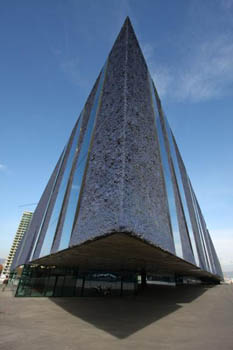Product Description
Wolfgang Gessl Cone teapot 1996


WOLFGANG GESSL (b. 1949) Austria / Sweden
Cone Teapot 1996 (designed 1995)
Hand wrought and hand hammered silver cone shaped covered pitcher form with a green PVC handle and spout over silver cylindrical arching forms
Marks: Wolfgang Gessl (script impressed signature), WO.GE (in a rectangle), Swedish assay mark for Stockholm, 925 (silver guarantee in a rectangle), X10 (in a rectangle), 2/9 GD 452
Illustrated: Gold and Silversmith Wolfgang Gessl: Exceeding Geometry, Kerstin Wickman, p. 19.
H: 8 3/8” x W: 8 ½” x Dia base: 5 ¼”
This is No. 2 out of the edition of 9 models.
Price: $22,500
Wolfgang Gessl was born in 1949 in Vienna, Austria and trained as a goldsmith with Professor Hans Angerbauer. Upon moving to Sweden, Gessl studied under the eminent silversmith Sigurd Persson at Konstfack, the National University of Art, Craft and Design in Stockholm, Sweden.
Wolfgang Gessl has had fifteen solo exhibitions including shows at The National Museum, Stockholm and The Royal College of Art in London. His metalwork has been widely exhibited in Sweden, Europe and the U.S and his pieces can be found in many private collections throughout the world. He has taught at Konstfack for more than twenty-four years, and continues to live and work in Stockholm.
Wolfgang Gessl Cone teapot 1996
KOLOMAN MOSER attr. (1868-1918) Austria
PORTOIS & FIX Vienna, Austria
Secessionist center table c. 1902
Exotic wood with brass inlaid squares, brass stretcher and feet with nickel-plated sabots
Marks: No. 29378 (inventory paper label), oval metal plaque in Russian with No. 798
***This table was likely exhibited at the 1902 Moscow Exhibition of Architecture and Applied Art and that is perhaps the reason for the Russian metal plaque.
For more information see: Art in Vienna, Peter Vergo (London: Phaidon Press Ltd., 1975), p. 139, footnote 88, p. 247.
H: 29” x W: 29” x L: 42 1/4”
Price: $42,500
